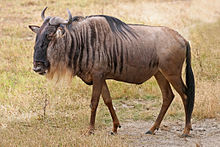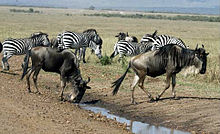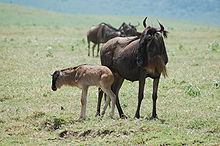
Blue wildebeest
Background Information
SOS Children have produced a selection of wikipedia articles for schools since 2005. See http://www.soschildren.org/sponsor-a-child to find out about child sponsorship.
| Blue Wildebeest | |
|---|---|
 |
|
| Male in the Ngorongoro Crater | |
| Conservation status | |
 Least Concern ( IUCN 3.1) |
|
| Scientific classification | |
| Kingdom: | Animalia |
| Phylum: | Chordata |
| Subphylum: | Vertebrata |
| Class: | Mammalia |
| Order: | Artiodactyla |
| Family: | Bovidae |
| Subfamily: | Alcelaphinae |
| Genus: | Connochaetes |
| Species: | C. taurinus |
| Binomial name | |
| Connochaetes taurinus ( Burchell, 1823) |
|
| Subspecies | |
|
C. t. taurinus, blue wildebeest or bridled gnu |
|
 |
|
|
C. t. taurinus
C. t. cooksoni
C. t. johnstoni
C. t. albojubatus
C. t. mearnsi
|
|
The blue wildebeest (Connochaetes taurinus), also called the common wildebeest or the white-bearded wildebeest, is a large antelope and one of two species of wildebeest. Males can grow to a 145 cm (57 in) shoulder height and attain a body mass of over 275 kg (610 lb). They range the open plains, bushveld, and dry woodlands of Southern and East Africa, living for more than 20 years. The male is highly territorial, using scent markings and other devices to protect his domain. The largest population is in the Serengeti, numbering over one million animals. They are a major prey item for lions, hyenas, and crocodiles.
Etymology
The name "blue wildebeest" derives from a conspicuous silvery-blue sheen to its short-haired hide, differentiating this species from the plainer black wildebeest. (The plural is denoted either "wildebeest" or "wildebeests".) Other common terms for wildebeest include gnu (pron.: / ˈ n uː / or / ˈ nj uː /) and nyumbu (Swahili). The name "gnu" originates from the Khoikhoi name for these animals, gnou. The animal's scientific name taurinus is Latin for "like a bull".
The blue wildebeest is sometimes called brindled gnu. The blue wildebeest and black wildebeest or white-tailed gnu (C. gnou) are the two species of the genus Connochaetes, within the family Bovidae, which includes antelopes, cattle, goats, and other even-toed horned ungulates.
Taxonomy and genetics
The blue wildebeest was first described by English naturalist William John Burchell in 1823. It shares the genus Connochaetes with the black wildebeest (C. gnou). Though the blue and black wildebeests are currently in the same genus, earlier reports have placed the former in a separate genus of its own, Gorgon. In a study of the mitotic chromosomes and mtDNA, intended to understand more of the evolutionary relations of the two species, it was revealed that the two species had diverged about a million years back, which showed a close phylogenetic relationship between them.
The diploid number of chromosomes in the blue wildebeest is 58. Chromosomes were studied in a male and a female wildebeest. In the female, all except a pair of very large submetacentric chromosomes were found to be acrocentric. Metaphases were studied in the male's chromosomes, and very large submetacentric chromosomes were found there as well, similar to those in the female both in size and morphology. Other chromosomes were acrocetric. The X chromosome is a large acrocentric and the Y chromosome a minute one.
Subspecies
C. taurinus consists of five subspecies:
- C. t. taurinus (Blue wildebeest or brindled gnu; southern Africa) individuals are silvery slate gray in colour, the origin of the common name "blue" wildebeest. * C. t. johnstoni (Nyassaland wildebeest), occurring in southeastern Tanzania and northern Mozambique), is the largest subspecies.
- C. t. mearnsi (Western white-bearded wildebeest) The smallest and is found only in southwestern Kenya and northwestern Tanzania. C. t. mearnsi is the darkest-hued wildebeest. Pale beard.
- C. t. albojubatus (Eastern white-bearded wildebeest) is the palest in colouration and found in southeastern Kenya and northeastern Tanzania. Pale beard.
- C. t. cooksoni (Cookson's wildebeest) Restricted to the Luangwa Valley.
Description
It has a muscular, front-heavy appearance, with a distinctive robust muzzle; it strides with relatively slender legs and moves gracefully and quietly most of the time, belying the reputation for stampeding in herds; however, the stampeding characteristic may sometimes be observed.
Probably the most conspicuous feature of the blue wildebeest are the large horns shaped like parentheses, extending outward to the side and then curving up and inward. In the male, the horns can attain a total span of almost 90 cm, while the females' horn width is about half the size of the males'. These cow-like horns of both sexes are somewhat broad at the base and are without ridges. However, as further sexual dimorphism, the male horns have a boss-like structure joining the two horns. The male is larger than the female. It is one of the largest species of antelope. The blue wildebeest can stand 118 to 145 cm (46 to 57 in) high at the shoulder. The head-and-body length can range from 150 to 250 cm (59 to 98 in) and the tail length ranges from 56 to 100 cm (22 to 39 in). Body mass is typically from 120 to 275 kg (260 to 610 lb). The record-sized female and male weighed 260 kg (570 lb) and 290 kg (640 lb), respectively.
Young blue wildebeest are born tawny brown, and begin to take on their adult colouration at age 9 weeks. The adults' hues actually vary from a deep slate or bluish gray all the way to light gray or even grayish-brown. The dorsal coat and flanks are slightly lighter in hue than the ventral hide and underparts. Dark brown vertical bands of slightly longer hair mark the neck and forequarters, and from a distance lend a perception of skin wrinkling. The manes of both sexes appear long, stiff, thick and jet black, a colour assumed by the tail and face, as well. Sexual dichromism is exhibited by the males displaying decidedly darker colouration than the females. All features and markings of this species are bilaterally symmetrical for both sexes.
Parasites
In a study, blue wildebeests were found to be hosts of 13 nematodes, one trematode, larvae of five oestrid flies, three species of lice, seven ixodid tick species, one mite and nymphae of a pentastomid. Of these most were seasonally prevalent. Blue wildebeest are resistant to infestations by several ticks.
Distribution and habitat
Blue wildebeest are found in open and bush-covered savanna in south and east Africa, thriving in areas that are neither too wet nor too arid. They can be found in places that vary from overgrazed areas with dense bush to open woodland floodplains. Wildebeest prefer the bushveld and grasslands of the southern savanna. The terrestrial biome designations for these preferred habitats are savanna, grassland, open forest and scrub forest.
Large herds numbering into the thousands may be observed on the Tanzanian Serengeti equatorial plain, and in Zambia in Liuwa Plain National Park, in their annual migration. Smaller herds of about 30 are found in northern Botswana, Zimbabwe, and the South African locations of Waterberg, Kruger National Park, and Mala Mala. Some herds can be found almost to the southern tip of South Africa.
Blue wildebeest can tolerate arid regions, as long as a potable water supply is available. Since all wildebeests require a long drink every day or two, they must have water within about 15 to 25 km distance. Their blunt muzzles are best equipped for biting short green grasses, since a wide incisor row prevents more selective feeding. Short grasses of this type are usually only found on alkaline or volcanic soils. Blue wildebeest are locally the favored prey for lions, spotted hyenas, and mature Nile crocodiles. The latter, giant reptiles, stalk them at river crossings and explosively grab them by their faces, dragging them into the water to drown. Lionesses usually attack them by ambush and then bite down onto their throats or sometimes snouts until they are suffocated. Hyenas usually kill wildebeest by repeatedly biting to the sides, ultimately causing death by shock and blood loss. The young also fall prey to cheetahs, leopards, and wild dogs, the last sometimes also take adults in if in a large pack.
Conservation
The Serengeti boasts over one million blue wildebeests, but southern Africa's large herds have diminished over the last several centuries under pressure from hunting, cattle ranching and habitat intrusion stemming from overpopulation of humans. In southern Africa, some efforts are being made to enhance grasslands and repair damage of cattle grazing and excessive fencing. These activities are particularly evident in the Waterberg Biosphere, where invasive brush (induced by excess cattle grazing) is being extirpated and many fences are coming down to promote wildlife migration. While the species status is considered secure as a whole, there is concern for smaller herds in the southern Africa habitats which have already become marginalized.
Behaviour
The Serengeti herds are purely migratory and abandon the usual plains after the rainy season has ended to seek higher grasses in wetter areas. Grasslands bordering alkaline lakes or pans are particularly choice dry-season (winter) habitats. Herds may be mixed gender with a dominant male, female only, or bachelor only. Blue wildebeest often graze together with other species such as plains zebras, for purposes of mutual protection. Zebras in particular are beneficial, since they mow down highly vegetated areas, leaving the wildebeests to eat the newly exposed and more nutritious short grasses, which they prefer. A blue wildebeest can attain maximum a speed of 65 to 80 kilometres per hour (40 to 50 mph).
Territoriality
Blue wildebeest are unusually territorial; adult males occupy their territories for a month or for the entire year. The physical size of territories ranges from one to two hectares. The bulls mark territory boundaries with dung heaps, preorbital gland secretions, hoof scent glands and pawing of the earth. When competing over territory, males grunt quite loudly, make a thrusting motion with their horns, and perform other displays of aggression.
Territories are advertised by actions of the bull, as well as physical marking. Body language used by the territorial male includes standing in an erect posture, profuse ground pawing and horning, frequent defecation, rolling on his back, and bellowing the sound "ga-noo". To attract the opposite sex at the beginning of courtship, the male (and less frequently the female) will rub its preorbital gland on a tree, and then proceed with a destructive horning of said tree. This behaviour is not only effective in enticing a mate, but also provides more grassland for future wildebeest generations by removing brush.
Reproduction
Males exhibit rivalry when staking out territory and when competing for females. In the actual clashes between males, they face off resting on bent front knees, exchanging horn thrusts for brief periods. Elaborate individual displays are made in the rivalry and courtship process, where males bellow, snort and dig their horns into the soil. The mating process is thought to begin at the first full moon at the end of the rainy season. Once territory is established, the male attempts to lure or corral the female into his domain. A female may mate with several different males, visiting several different territories. Most mating occurs during a three- to four-week period at the end of the rainy season (March to April), when this species is at its maximum vigour.
The female reaches sexual maturity at age three, and the male at age four; however, it is more typically age five when the male has developed sufficient strength and experience to defend territory. Generally, fewer than half of the adult males create territories in a given year. In the Serengeti, population densities are very high, up to 270 territorial bulls may occupy one square kilometer. The total volume of noise created during the Serengeti rutting season is "indescribable" in its amplitude and variety of snorting, bellowing and fighting. When the dry season is well underway, usually sometime in August, territories are no longer defended.
The gestation period is about 8.5 months. Female wildebeest give birth in the middle of a herd rather than alone, and typically in the middle of the day, in order to give some time for the newborn to practice walking before the predators become active again after sunset. Calves are able to stand within seven minutes and run with the herd in less than two hours from birth. These precocial features are warranted, since the calves are vulnerable to predators. To escape predation, calves remain close to their mothers for a significant time, and may suckle for up to one year. In large herds, 80% of wildebeest offspring survive the first month, compared to a 50% survival rate within small herds.






